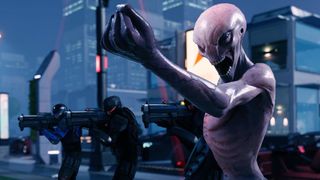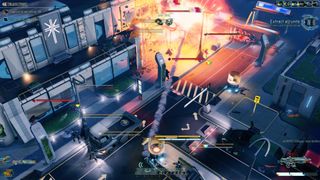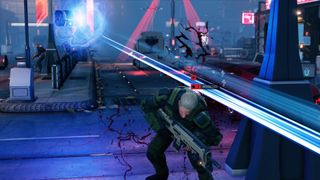The Long War 2 mod is a must-play reinvention of XCOM 2
New classes, weapons, and a reworked campaign map successfully refresh this excellent strategy game.

The word 'mod' undersells The Long War 2. 'Mod' implies an aesthetic tweak, a UI correction, a new weapon perhaps. In fact this is XCOM 2 as developed in a parallel universe. The Long War 2 does add lots of new weapons, classes and skills, but all these service a set of bespoke design aims that turn XCOM 2 from a survival strategy game into a gradually paced army and territory management sim with expanded combat encounters.
For players that have mastered XCOM 2's story and power arcs, or now find them predictable, Long War 2 is an essential download. The mod forces you to break out of your habits and re-engage with the game again at the most basic level. Even soldiers are valued differently. You can field up to ten in a mission, and you start with a large roster. Consequently, losing agents isn't the body blow it can be in trad XCOM, and you have more room to experiment with ability and weapon combinations across your force.
Your whole stance as resistance commander feels different to ordinary XCOM 2, which forces you into a reactive position with must-fight emergency missions. In The Long War 2 missions are more like leads that you can choose to spend time and resources to follow up. Ordinary missions are preceded by an infiltration period that asks you to devote a squad to a location for a variable number of days. If they achieve a high degree of infiltration (represented by a percentage marker that ticks upwards with each day), they face weaker forces in that mission.

This introduces some new opportunities to XCOM 2. Firstly, you can take a pass on missions. Second: it's entirely viable, and often useful, to send an under-strength squad to a mission, because smaller squads can infiltrate more quickly and effectively. This creates an interesting separation within your roster, between large teams of newbies and small teams of highly-levelled, well-equipped crack special forces operatives. Moving between sub-squads introduces more variety to combat encounters as well. In XCOM 2 you're likely to develop a small team of very precious warriors. In the Long War you nurture a broad, diverse stable over a longer period.
Even if you decide to deploy a small squad, combat encounters tend to be busier. Enemy reinforcements can drop in while you're waiting for extraction. If a mission is going badly and you choose to extract, you have to wait longer for your ship to arrive, and thus fend off more enemies. There are new enemy varieties too, such as colour-coded versions of ordinary advent soldiers with different loadouts and behaviours. These expanded firefights have an interesting effect on the way chance operates. By growing the number of chance rolls the game makes, the effects of variance are reduced over time. You will still see massive swings of good and bad luck of course, but the length of the campaign and the reduced value of soldiers softens XCOM 2's harshest elements. The extra bit of ablative armour that recruits wear also helps.
The extra soldiers and the glut of missions gives you more room to enjoy the new classes. The sword-wielding Shinobi shares some similarity to the assault class, but with a much greater emphasis on stealth and ambush tactics. At high levels, with the right skills, Shinobi can break stealth, attack multiple enemies and re-enter concealment, or mitigate damage with buffed evasion rolls (dodging an attack means you take a small amount of 'graze' damage, far preferable to the full-whack when fighting mid-tier enemies upwards). They are supported by knives and swords, and benefit from the new SMG weapons, which let you sacrifice mid-range accuracy for speed. There's also a new Technical class, members of which wields a wrist-mounted flame-thrower/rocket launcher secondary combo weapon, which is as amazing as it sounds.

There are plenty of new mission types for these new soldiers to tackle, including prison break-outs and enemy base assaults. The rewards for these missions have been redesigned to affect the heavily reworked map layer. You still fly the Avenger around the globe to camp on spots and suck up resources or activate missions, but The Long War 2 introduces an additional layer of territory management. Once you've made contact with the resistance in an area you can assign resistance members based there to different jobs that generate supply and intel. You can assign engineers and scientists to regions to supply additional boosts. Resistance members can also fend off alien influence in an area, and Advent moves troops around on the map in an effort to install new alien bases and move the Avatar project forward.
PC Gamer Newsletter
Sign up to get the best content of the week, and great gaming deals, as picked by the editors.
The changes bring a dose of 4X strategy to XCOM 2. This slows the pace considerably—this is the Long War, after all. This dilutes the impact and drama of an XCOM 2 campaign to an extent. The way the core game gives you a narrow stream of high-stakes decisions is one of the reasons I loved it so much when I reviewed it last year. However I've found it fascinating to see how XCOM's core mechanics work in this new context. The Long War 2 is a thoughtful and effective reworking of the XCOM 2 formula, and the new weapon, class and mission additions are slick and well-integrated—they could have come from Firaxis.
Speaking of Firaxis, it's great to see studios work with modders, particularly in instances where the mod team wants to substantially rework the studio's original vision. The result is a neat Earth-B take on the concept that unlocks hundreds of hours of extra playtime. The Long War 2 is out now, and it's free.
Part of the UK team, Tom was with PC Gamer at the very beginning of the website's launch—first as a news writer, and then as online editor until his departure in 2020. His specialties are strategy games, action RPGs, hack ‘n slash games, digital card games… basically anything that he can fit on a hard drive. His final boss form is Deckard Cain.
Most Popular






